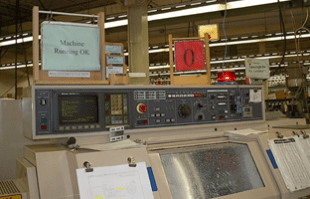A Blog About Understanding The Toyota Production System and Gaining Its Full Benefits, brought to you by "The Toast Guy"

Do Your Job
We had been working with TSSC for two years to build a model line in our assembly department. As we moved from small batch production to one-by-one, the results had been astounding: customer lead-time reduced from 2 weeks to one day, crew size cut in half and over-time reduced from 40 hours per week to 10. Literally hundreds of small changes made by assemblers to the assembly process had made this possible. Everybody everyday, GBMP’s slogan, was born from that experience.
Now it was time to move upstream from assembly to our internal supplier, machining, a resource that despite efforts to improve was still overproducing and delivering late. Setups on our CNC lathes averaged 90 minutes despite an improvement project supported by graduate engineers from a notable Massachusetts engineering school. In fact, at the end of a one-year project, while we had learned a lot about new cutting materials and had purchased two new machines, there was hardly any improvement in set-up times. We were forced to group like set-ups together to amortize set-up time and even come close to maintaining a reliable parts store. So, with some disappointment we thanked the graduate engineers, sent them on their way and instead requested assistance from TSSC.
Our Sensei (a term I use very sparingly), Hajime Oba, responded to our request with a visit to our machine shop. “Hmm,” Mr. Oba muttered as he walked around one of our old CNC lathes. “All of the parts for your model line assembly will be made on this machine and changeover between any two parts must be less than 9 minutes. Work only on this machine. That is your target” I squelched an urge to guffaw and politely replied “Okay, we’ll do it.” Privately, I thought, “I’ve seen die changes on presses done in minutes, but how will we accomplish this on a lathe?”

Three weeks later, TSSC, sent a consultant to help us begin the improvement process. This young, 20-ish industrial engineer, Ann, was the daughter of the owner of a Toyota supplier. I’m pretty sure she’d had no previous experience with CNC lathes. But, off we walked to the machine shop with nothing more than an easel for recording observations. As I introduced her to the operators, there were rolling eyes and grins. They’d just finished a year with another group of engineers who were, let’s say, snobs. This looked like the same old stuff to the shop.
Ann introduced herself and said she just wanted to watch the process and might have a few questions. As the day wore on, I stopped by periodically to check-in. Ann was watching the work and the operators were mostly ignoring her. At the end of the day, nothing was written on the easel. We’d start again the following morning.
I noticed on day two that there was a little bit of communication. Operators were sharing. Ann did not talk much. She just watched and listened. I expected a report from her at end of day to sum up her first visit to our plant. Working with TSSC in assembly, I’d come to expect a list of must-do’s before her next visit. Oddly, the easel was still blank at mid-day on day two.
As day two wrapped up, Ann asked for a meeting with me. As we stood by the BNC, the lathe where the improvement was to be made, Ann said, “This lathe needs an overhaul. It’s not repeatable and improving changeovers will be impossible. I’ll be back in three weeks.”
“Three weeks!”, I exclaimed. “There’s no way I can get that done in three weeks.” I should have expected the next words out of her mouth: “Ok then. If you can’t do your job, then I can’t do mine.” This ultimatum yanked me back to reality. “I’ll get it done, then. I’m not sure how, but we’ll make it happen.” And it did.
Three weeks later, Ann returned. “I’m glad you could get this done,” she told me. “Now we can get to work.” At the end of her two-day visit there were eight pages of notes on the easel with my next list of must-dos highlighted. There were no monumental tasks this time, just a whole lot of requests from the operators. As we went over the list, I saw a gleam in eyes of a couple operators. Would I follow up on these ideas? Absolutely!
By Ann’s third visit, with the help of an employee Kaizen support team, CNC set-up reduction was now accelerating: set locations for tools and inserts, materials near to the machine, programs standardized, downloaded and ready to go. Just as in assembly, CNC operators were inventing hundreds of small improvements. In a short time, most changeovers were close to 20 minutes – or, as we started to say, 1200 seconds – and on-time delivery to assembly was near to 100%.
I couldn’t set-up or even operate a CNC machine, and all of the improvements had come from the operators. But there was a job for me and in this case I did my job. Still, we had not reached the goal of 9 minute changeovers. Stay tuned for that in my next post.
O.L.D.
Hey! We’re just one month away from Second Annual Spring Roadshow. On April 1st, thanks the magic of Whova and Zoom , we’ll be showcasing best practices at 9 different organizations from Florida to Massachusetts. You can join in for all or part to go-see virtually and then ask questions of employee teams. And we’ll be recording, so there’s an opportunity to watch again later at your leisure. What a great way to kick of the Spring season. Here’s the link for more information: Lean Spring Showcase.